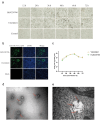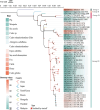Genomic surveillance and evolution of Getah virus
- PMID: 39989716
- PMCID: PMC11844246
- DOI: 10.1093/ve/veaf007
Genomic surveillance and evolution of Getah virus
Abstract
Getah virus (GETV), a member of the Alphaviruses, has spread widely and is expanding its host range worldwide, posing a serious threat to public health safety and the farming industry. However, genetic monitoring of GETV is inadequate, and its evolution and transmission remain unclear. This study employed reverse transcription-polymerase chain reaction to screen pig tissue samples for the presence of GETV. Subsequent steps included DNA sequencing, phylogenetic analysis, and selection pressure assessments to elucidate the evolutionary history and transmission patterns of the virus. A total of 1382 samples were examined, with a positivity rate of 4.12% (95% confidence interval: 3.07%-5.17%) from 2022 to 2023. Subsequently, seven GETV strains were isolated and identified. A phylogenetic tree was constructed, which showed that all seven strains belonged to Group III. Phylodynamic analysis revealed that GETV evolved rapidly. Additionally, eight amino acid sites within the GETV E2 protein were identified as being under positive selection. These data provide insight into the epidemiology and evolution of GETV.
Keywords: Getah virus; alphavirus; epidemiology; evolution; phylogenetic dynamics.
© The Author(s) 2025. Published by Oxford University Press.
Conflict of interest statement
This manuscript has been reviewed and approved by all authors. There are no commercial or financial relationships that would lead to a potential conflict of interest.
Figures







Similar articles
-
Early Genomic Surveillance and Phylogeographic Analysis of Getah Virus, a Reemerging Arbovirus, in Livestock in China.J Virol. 2023 Jan 31;97(1):e0109122. doi: 10.1128/jvi.01091-22. Epub 2022 Dec 8. J Virol. 2023. PMID: 36475767 Free PMC article.
-
Origin, genetic diversity, adaptive evolution and transmission dynamics of Getah virus.Transbound Emerg Dis. 2022 Jul;69(4):e1037-e1050. doi: 10.1111/tbed.14395. Epub 2021 Dec 13. Transbound Emerg Dis. 2022. PMID: 34812572
-
First report on identification and genetic characterization of Getah virus in wild boar in China.Front Microbiol. 2025 Mar 24;16:1583023. doi: 10.3389/fmicb.2025.1583023. eCollection 2025. Front Microbiol. 2025. PMID: 40231237 Free PMC article.
-
Genomic characterization and evolutionary analysis of a Getah virus variant from piglets in central China.Front Microbiol. 2025 Feb 5;16:1515632. doi: 10.3389/fmicb.2025.1515632. eCollection 2025. Front Microbiol. 2025. PMID: 39973930 Free PMC article.
-
Getah Virus (Alphavirus): An Emerging, Spreading Zoonotic Virus.Pathogens. 2022 Aug 20;11(8):945. doi: 10.3390/pathogens11080945. Pathogens. 2022. PMID: 36015065 Free PMC article. Review.
Cited by
-
Outbreak and epidemic of Getah virus infection in swine by virulence-enhanced GIII variant in Henan, central China in 2024.Virulence. 2025 Dec;16(1):2530661. doi: 10.1080/21505594.2025.2530661. Epub 2025 Jul 13. Virulence. 2025. PMID: 40653751 Free PMC article.
References
LinkOut - more resources
Full Text Sources

